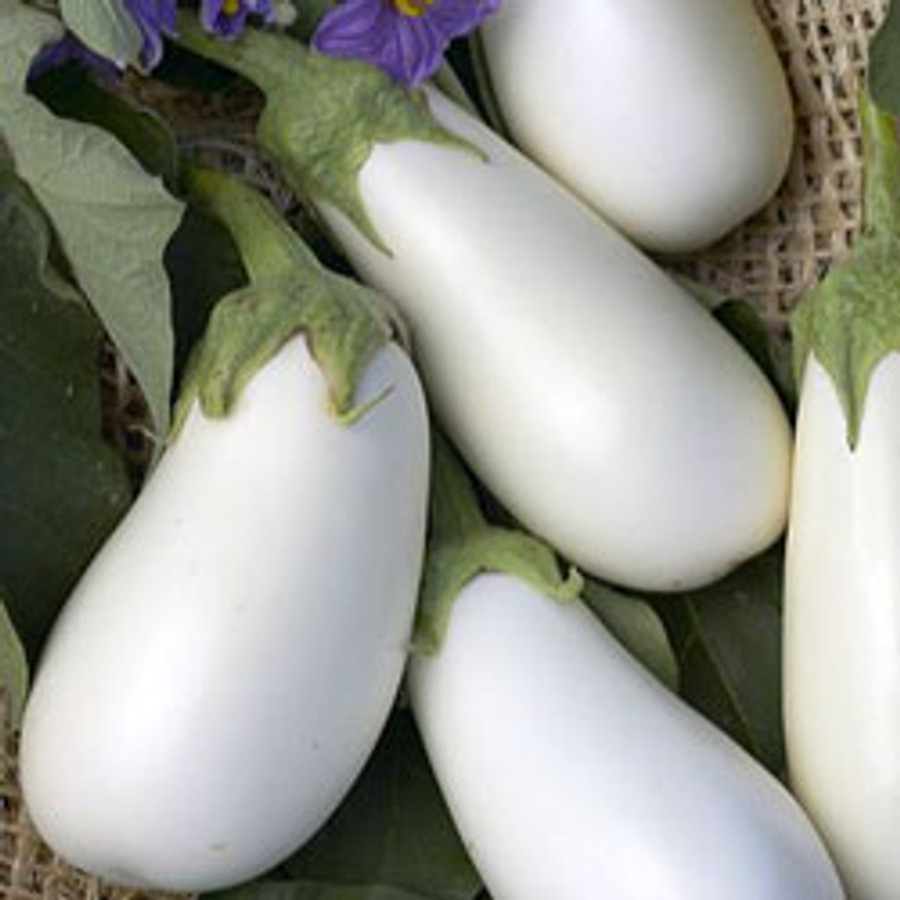1/8 g
65 days. The pinnacle of quality in white, Italian eggplant! Vigorous plants produce continuous, healthy harvests of pristine, teardrop-shaped, ivory-colored fruit. Snowy ripens earlier and resists yellowing better than traditional white varieties, and these firm eggplants are delectable and especially well-suited for roasting.
Solanum melongena Although the eggplant is a staple in cultures worldwide, this culinary oddity is ignored by far too many American gardeners and deserves a spot in the garden. Eggplants are remarkably versatile, taking on the flavor of whatever they are cooked with. They are very low in calories and fat, high in fiber, a good source of an assortment of minerals, and have a very low glycemic index.
Days to maturity are calculated from transplant date.
Culture
• Eggplants are heat-loving plants that require a long growing season
• Plants grow best in fertile, well-drained soil; raised beds and black mulch provide extra warmth in the spring
• Use row cover until first blooms appear
• Optimum growth occurs with day temp. of 80-90°F and night temp. of 70+°F
Direct Sowing
• Not recommended
Transplanting
• Sow indoors 8-10 weeks prior to anticipated transplant date
• When plants have their second set of true leaves, up-pot them into 3-4 inch pots, 1 per container
• Transplant hardened-off plants when night temperatures are above 50°F
• Use 1/2 cup TSC's Complete fertilizer and a shovelful of compost around each plant
Insects & Diseases
• Common insects: Flea beetles, aphids, and potato beetles
• Insect control: Pyrethrin and row covers
• Common diseases: Verticillium and Fusarium wilts
• Disease prevention: 3-4 year crop rotation
Harvest & Storage
• Harvest when skin is still smooth and shiny
• Over mature fruit will be soft and seed will begin to darken
• Fruit can be held 7-10 days at 45-55°F and 90-95% humidity
KEY TO EGGPLANT DISEASE RESISTANCE AND TOLERANCE
B | Bacterial Wilt
BO | Botrytis, Gray Mold
ToMV | Tomato Mosaic Virus
65 days. The pinnacle of quality in white, Italian eggplant! Vigorous plants produce continuous, healthy harvests of pristine, teardrop-shaped, ivory-colored fruit. Snowy ripens earlier and resists yellowing better than traditional white varieties, and these firm eggplants are delectable and especially well-suited for roasting.
Solanum melongena Although the eggplant is a staple in cultures worldwide, this culinary oddity is ignored by far too many American gardeners and deserves a spot in the garden. Eggplants are remarkably versatile, taking on the flavor of whatever they are cooked with. They are very low in calories and fat, high in fiber, a good source of an assortment of minerals, and have a very low glycemic index.
Days to maturity are calculated from transplant date.
Culture
• Eggplants are heat-loving plants that require a long growing season
• Plants grow best in fertile, well-drained soil; raised beds and black mulch provide extra warmth in the spring
• Use row cover until first blooms appear
• Optimum growth occurs with day temp. of 80-90°F and night temp. of 70+°F
Direct Sowing
• Not recommended
Transplanting
• Sow indoors 8-10 weeks prior to anticipated transplant date
• When plants have their second set of true leaves, up-pot them into 3-4 inch pots, 1 per container
• Transplant hardened-off plants when night temperatures are above 50°F
• Use 1/2 cup TSC's Complete fertilizer and a shovelful of compost around each plant
Insects & Diseases
• Common insects: Flea beetles, aphids, and potato beetles
• Insect control: Pyrethrin and row covers
• Common diseases: Verticillium and Fusarium wilts
• Disease prevention: 3-4 year crop rotation
Harvest & Storage
• Harvest when skin is still smooth and shiny
• Over mature fruit will be soft and seed will begin to darken
• Fruit can be held 7-10 days at 45-55°F and 90-95% humidity
KEY TO EGGPLANT DISEASE RESISTANCE AND TOLERANCE
B | Bacterial Wilt
BO | Botrytis, Gray Mold
ToMV | Tomato Mosaic Virus
